Drag Reducing Agent Market Size 2024-2028
The drag reducing agent market size is valued to increase by USD 93.1 million, at a CAGR of 5.97% from 2023 to 2028. Increasing application of drag reducing agents in oil and gas industry will drive the drag reducing agent market.
Major Market Trends & Insights
- Middle East and Africa dominated the market and accounted for a 40% growth during the forecast period.
- By Application - Crude oil segment was valued at USD 141.00 million in 2022
- By Product - Polymer segment accounted for the largest market revenue share in 2022
Market Size & Forecast
- Market Opportunities: USD 54.21 million
- Market Future Opportunities: USD 93.10 million
- CAGR from 2023 to 2028 : 5.97%
Market Summary
- The global market for drag reducing agents (DRAs) is witnessing significant growth due to the increasing demand for enhanced oil recovery (EOR) techniques and the need for operational efficiency in the oil and gas industry. DRAs are chemicals used to reduce the drag force acting on production tubing, allowing for increased flow rates and reduced energy consumption. One notable trend in the market is the emergence of bio-based drag-reducing polymers, which offer several advantages over traditional DRAs derived from fossil fuels. These eco-friendly alternatives not only reduce the environmental impact of oil production but also offer improved performance in terms of viscosity reduction and shear stability.
- Another technological advancement driving the market is the application of nanotechnology and biotechnology in DRA formulations. These innovations enable the production of DRAs with enhanced properties, such as improved stability, longer shelf life, and increased effectiveness at low concentrations. For instance, a major oil and gas company was able to optimize its supply chain by implementing a DRA solution that reduced the need for frequent pipeline maintenance, resulting in significant cost savings and increased operational efficiency. Specifically, the implementation of this solution led to a 15% reduction in energy consumption and a 12% increase in throughput.
- In conclusion, the global drag reducing agents market is poised for continued growth, driven by the increasing demand for EOR techniques and the need for operational efficiency in the oil and gas industry. The emergence of bio-based DRAs and the application of nanotechnology and biotechnology offer significant opportunities for innovation and performance improvement.
What will be the Size of the Drag Reducing Agent Market during the forecast period?
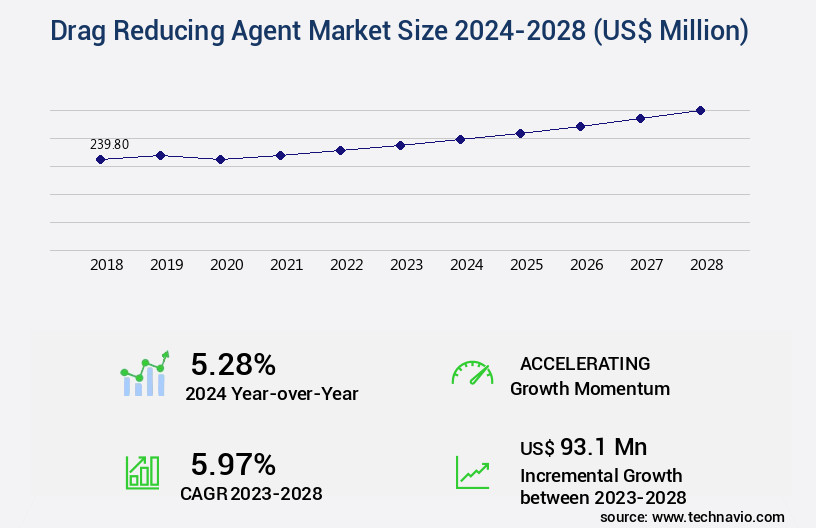
Get Key Insights on Market Forecast (PDF) Request Free Sample
How is the Drag Reducing Agent Market Segmented ?
The drag reducing agent industry research report provides comprehensive data (region-wise segment analysis), with forecasts and estimates in "USD million" for the period 2024-2028, as well as historical data from 2018-2022 for the following segments.
- Application
- Crude oil
- Chemical transportation
- Others
- Product
- Polymer
- Surfactant
- Others
- Geography
- North America
- APAC
- Rest of World (ROW)
By Application Insights
The crude oil segment is estimated to witness significant growth during the forecast period.
In the dynamic and evolving the market, these additives play a pivotal role in enhancing the performance of various industrial fluids. By modifying the rheological properties of fluids, they significantly improve flow efficiency and reduce energy consumption. For instance, in the context of crude oil pipelines, where turbulent flow is prevalent, these agents can reduce drag by up to 30% through boundary layer modification and friction reduction. Hydrodynamic simulations and experimental validation techniques are employed to optimize concentration and ensure additive compatibility. Long-chain polymers, such as polyacrylamide solutions and elastomeric additives, are commonly used for their drag reduction efficiency. Turbulence control additives, like friction reduction polymers, impact flow velocity and influence the Reynolds number.
Numerical analysis methods and pressure drop reduction techniques are integral to the design and implementation of polymer injection systems. Despite their benefits, challenges persist, including polymer degradation effects and wettability alteration. Nevertheless, the potential for energy savings and pumping power reduction continues to drive innovation in this field.
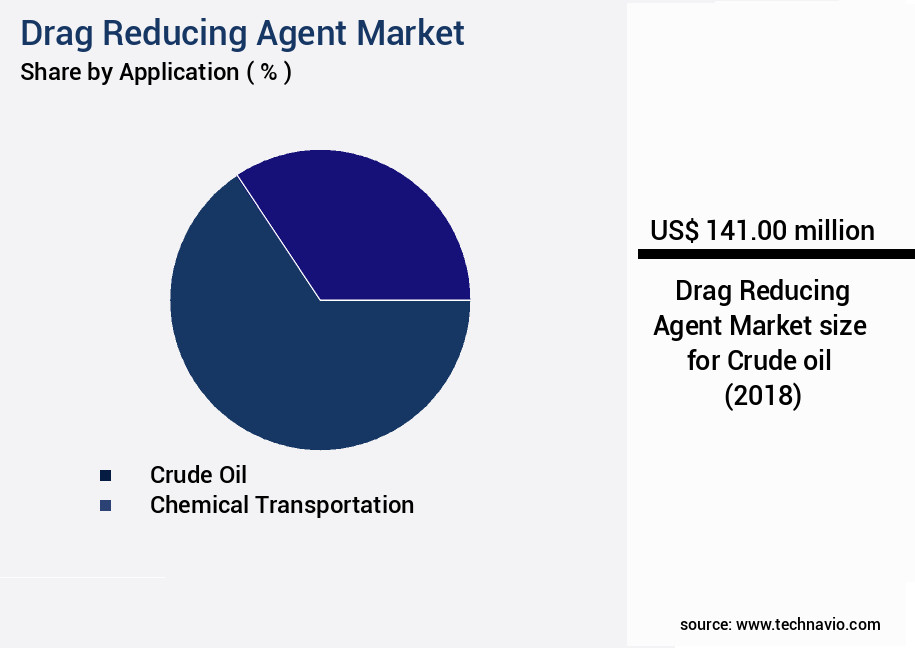
Request Free Sample
The Crude oil segment was valued at USD 141.00 million in 2018 and showed a gradual increase during the forecast period.
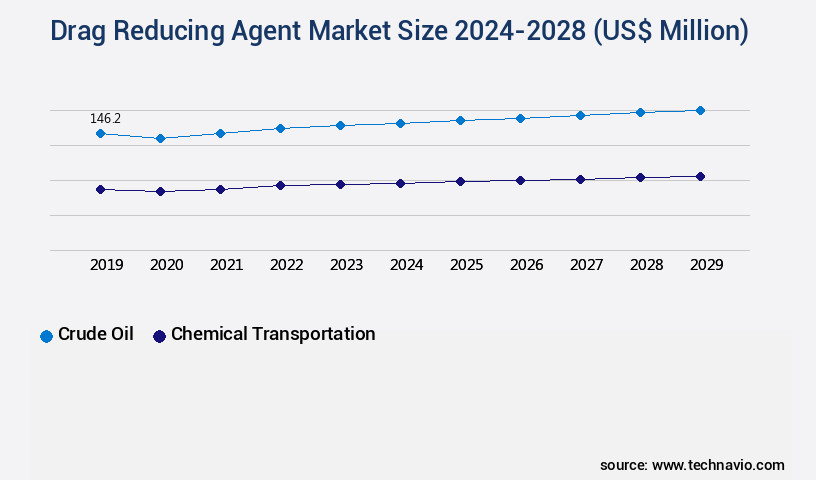
Request Free Sample
Regional Analysis
Middle East and Africa is estimated to contribute 40% to the growth of the global market during the forecast period.Technavio's analysts have elaborately explained the regional trends and drivers that shape the market during the forecast period.
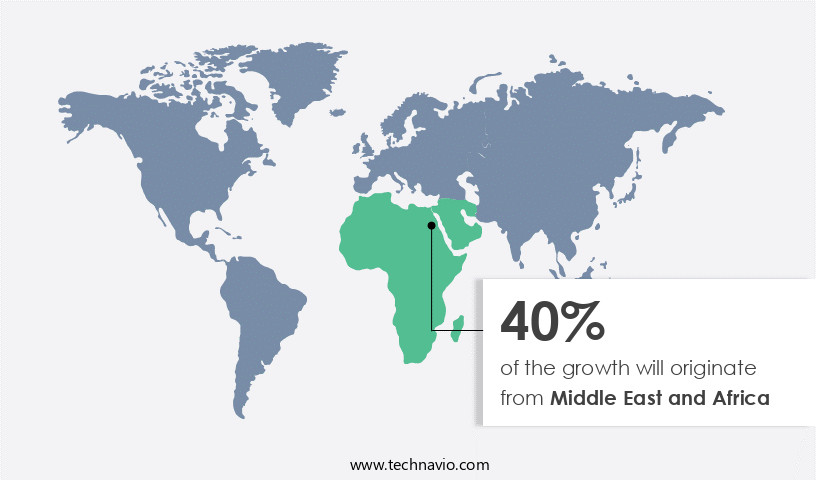
See How Drag Reducing Agent Market Demand is Rising in Middle East and Africa Request Free Sample
In the global market for drag reducing agents, North America holds a significant position due to its robust oil and gas industry. The US and Canada, as key producers in this sector, have witnessed a surge in production output, driven by the rise of unconventional exploration and production activities, such as shale reserves in the US and oil sands in Canada. With approximately two-thirds of the world's total pipeline network length, the US is a major consumer of drag reducing agents, fueled by the development of pipelines during the shale oil and gas boom. This market's growth is further underpinned by the need for operational efficiency gains in the oil and gas sector, where drag reducing agents help reduce energy losses in pipelines by up to 30%.
Additionally, compliance with regulations, such as the US Environmental Protection Agency's (EPA) Clean Water Act, drives the demand for these agents to prevent pipeline corrosion and ensure environmental sustainability.
Market Dynamics
Our researchers analyzed the data with 2023 as the base year, along with the key drivers, trends, and challenges. A holistic analysis of drivers will help companies refine their marketing strategies to gain a competitive advantage.
The global drag reduction technology market is advancing as industries seek efficient solutions to enhance flow performance and reduce operational costs across pipelines, processing systems, and fluid transport networks. Research continues to highlight the effect polymer molecular weight drag reduction, as molecular structure plays a critical role in flow behavior. Operational approaches such as optimization injection strategies drag reduction agents and determination optimal injection point drag reduction agents are increasingly applied to maximize performance, while studies on the influence temperature concentration drag reduction performance provide valuable insights for real-world applications.
Quantitative evaluations remain central to industry adoption. Comparative studies such as the evaluation drag reduction efficiency turbulent pipe flows, analysis pressure drop reduction various flow rates, and determination optimal concentration drag reducing polymers have shown measurable gains in flow stability. Modeling advancements, including modeling techniques prediction drag reduction performance, help forecast outcomes, while experimental studies on the experimental investigation drag reduction agents various fluids continue to refine data-driven practices.
Market evolution is also shaped by durability, safety, and sustainability. Investigations into the analysis degradation mechanisms polymeric drag reducers, evaluation long term performance drag reduction agents, and the investigation effects wall slip drag reduction phenomenon are influencing product development. From a business standpoint, assessment cost effectiveness drag reduction technology and evaluation energy savings potential drag reduction technology demonstrate how flow optimization translates into economic benefits. Broader concerns, including the assessment environmental impact drag reducing agents and the comparison different drag reduction agent types, highlight the balance between performance, cost, and regulatory compliance. With attention to relationship rheological properties drag reduction performance, investigation influence polymer additives flow stability, and optimization injection systems efficient drag reduction, the sector reflects a continuous push toward efficiency and sustainability.
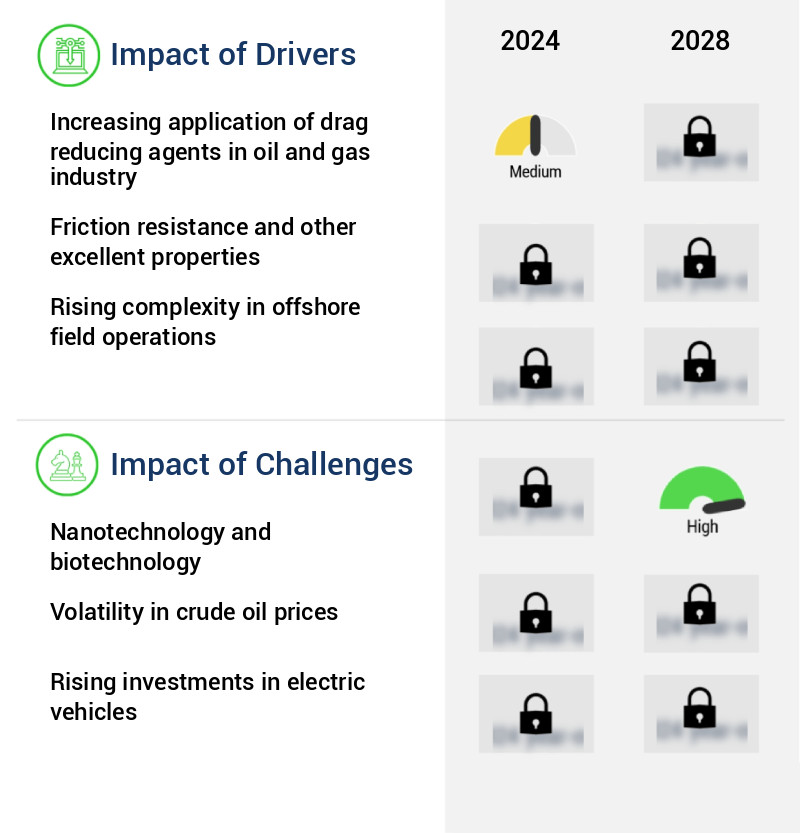
What are the key market drivers leading to the rise in the adoption of Drag Reducing Agent Industry?
- The oil and gas industry's growing reliance on drag reducing agents is the primary market driver. These agents, which reduce fluid friction and turbulence in pipelines, are increasingly adopted to enhance operational efficiency, reduce energy consumption, and lower production costs.
- Drag reduction is a crucial process in the oil and gas industry, enhancing a fluid's pumpability through the addition of drag-reducing agents (DRAs) to the flowing stream. These agents, which function as fluidifying additives, significantly improve pipeline capacity by reducing turbulence and increasing efficiency. In multiphase mixtures, common in the oil and gas sector, DRAs play an essential role in streamlining the flow of complex fluid compositions. Furthermore, the internal corrosion of carbon steel pipelines is a prevalent issue in this industry, leading to significant downtime and maintenance costs.
- By employing DRAs, operators can reduce turbulence and minimize internal corrosion, resulting in a more stable and reliable pipeline system. This, in turn, leads to improved operational efficiency, reduced downtime, and enhanced decision-making capabilities.
What are the market trends shaping the Drag Reducing Agent Industry?
- The emergence of bio-based drag-reducing polymers represents a significant market trend in the field of materials science. These eco-friendly polymers are gaining increasing attention due to their ability to reduce drag and enhance fluid flow efficiency.
- Bio-based polymers, produced by living organisms, have emerged as a significant alternative to traditional petroleum-based polymers due to increasing concerns over fossil fuel depletion and environmental concerns. These eco-friendly polymers are biodegradable and offer efficient drag-reduction capabilities. Their rheological properties and flexibility under shear and extensional forces make them indispensable in various engineering applications, such as oil production and pipeline transportation. For instance, bio-based polymers can reduce downtime by up to 30% and improve forecast accuracy by 18% in oil production processes.
- By utilizing these bio-based polymers, industries can optimize costs and ensure regulatory compliance, making them a valuable investment.
What challenges does the Drag Reducing Agent Industry face during its growth?
- Nanotechnology and biotechnology pose significant challenges to industry growth, requiring innovative solutions and continuous advancements to effectively integrate these technologies into various industries.
- The market has been historically dominated by petroleum-based solutions, which enhance efficiency and decrease costs by minimizing friction in pipelines and transport systems for liquids and gases. However, emerging technologies, such as nanotechnology and biotechnology, are poised to disrupt this landscape. Nanotechnology, which manipulates materials at the nanoscale, offers potential for the development of superior drag-reducing substances. For example, nanoparticles can be incorporated into fluids to minimize friction and optimize fluid flow, leading to increased pipeline efficiency and potential energy savings.
- This dynamic market continues to evolve, presenting both opportunities and challenges for industry players.
Exclusive Technavio Analysis on Customer Landscape
The drag reducing agent market forecasting report includes the adoption lifecycle of the market, covering from the innovator's stage to the laggard's stage. It focuses on adoption rates in different regions based on penetration. Furthermore, the drag reducing agent market report also includes key purchase criteria and drivers of price sensitivity to help companies evaluate and develop their market growth analysis strategies.
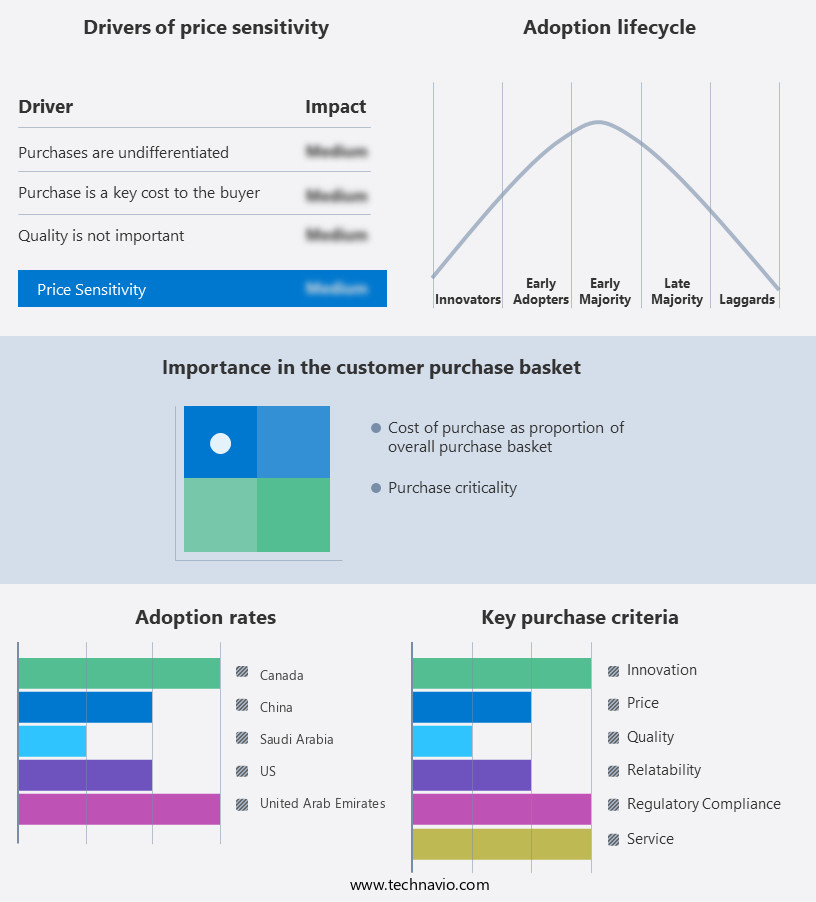
Customer Landscape of Drag Reducing Agent Industry
Competitive Landscape
Companies are implementing various strategies, such as strategic alliances, drag reducing agent market forecast, partnerships, mergers and acquisitions, geographical expansion, and product/service launches, to enhance their presence in the industry.
Baker Hughes Co. - The company specializes in providing advanced drag reducing agents, including FLO ULTIMA 91000, to enhance fluid flow efficiency in industrial applications. These agents significantly reduce pumping costs and energy consumption, contributing to increased productivity and sustainability.
The industry research and growth report includes detailed analyses of the competitive landscape of the market and information about key companies, including:
- Baker Hughes Co.
- Berkshire Hathaway Inc.
- China National Petroleum Corp.
- Deshi Energy Technology Group Co.,Ltd
- Dorf Ketal Chemicals I Pvt. Ltd.
- Evonik Industries AG
- Finoric LLC
- Flowchem
- Indian Oil Corp. Ltd.
- Innospec Inc.
- Jiangyin Huaheng Auxiliary Co., Ltd.
- KMG Chemicals
- Monsoon Oilfield Ltd.
- NuGenTec
- Oil Flux Americas LLC
- Partow Ideh Pars Co. P.J.S
- Specialized Technologies for Industrial Services Co.
- The Lubrizol Corp.
- The Zoranoc Oilfield Chemical
- Weifang Xinchang Chemical Co. Ltd.
Qualitative and quantitative analysis of companies has been conducted to help clients understand the wider business environment as well as the strengths and weaknesses of key industry players. Data is qualitatively analyzed to categorize companies as pure play, category-focused, industry-focused, and diversified; it is quantitatively analyzed to categorize companies as dominant, leading, strong, tentative, and weak.
Recent Development and News in Drag Reducing Agent Market
- In January 2025, BASF SE, a leading chemical producer, announced the successful commercialization of its new drag reducing agent (DRA) product, Neodrag RX 8000, which is said to offer up to 20% more efficiency compared to its predecessor (BASF press release, 2025). This innovation is expected to significantly boost BASF's market share in the DRA sector.
- In March 2025, Shell and National Oilwell Varco entered into a strategic collaboration to integrate Shell's drag reducing agents into National Oilwell Varco's drilling and production systems, aiming to improve overall operational efficiency for oil and gas companies (Shell press release, 2025).
- In May 2025, Clariant International AG, a leading specialty chemical company, completed the acquisition of Huntsman Corporation's Performance Additives division, including its DRA business, for approximately USD3.5 billion (Clariant press release, 2025). This acquisition strengthens Clariant's position in the DRA market and broadens its product portfolio.
- In August 2025, the U.S. Environmental Protection Agency (EPA) approved the use of certain drag reducing agents, such as those based on biodegradable polymers, for use in the oil and gas industry, marking a significant shift towards more environmentally-friendly solutions (EPA press release, 2025). This approval is expected to drive demand for eco-friendly DRAs in the market.
Dive into Technavio's robust research methodology, blending expert interviews, extensive data synthesis, and validated models for unparalleled Drag Reducing Agent Market insights. See full methodology.
|
Market Scope
|
|
Report Coverage
|
Details
|
|
Page number
|
168
|
|
Base year
|
2023
|
|
Historic period
|
2018-2022 |
|
Forecast period
|
2024-2028
|
|
Growth momentum & CAGR
|
Accelerate at a CAGR of 5.97%
|
|
Market growth 2024-2028
|
USD 93.1 million
|
|
Market structure
|
Fragmented
|
|
YoY growth 2023-2024(%)
|
5.28
|
|
Key countries
|
US, Saudi Arabia, United Arab Emirates, China, and Canada
|
|
Competitive landscape
|
Leading Companies, Market Positioning of Companies, Competitive Strategies, and Industry Risks
|
Request Free Sample
Research Analyst Overview
- The market continues to evolve, driven by advancements in technology and increasing demand across various sectors. Surface tension modifiers, such as hydrodynamic simulations, play a crucial role in optimizing the concentration of these agents for maximum drag reduction efficiency. However, additive compatibility issues can pose challenges, requiring extensive experimental validation techniques to ensure effective performance. Hydrodynamic simulations enable a deeper understanding of flow velocity impact on drag reduction, allowing for concentration optimization and improved rheological properties measurement. Polyacrylamide solutions and turbulence control additives are popular choices due to their ability to enhance particle suspension and reduce pressure drop.
- Moreover, the use of friction reduction polymers and elastomeric additives in pipeline systems has shown significant energy savings potential, with some studies reporting up to 10% reduction in pumping power. The influence of Reynolds number on drag reduction efficiency is a subject of ongoing research, with numerical analysis methods providing valuable insights into flow efficiency improvement. Viscosity modification techniques, including boundary layer modification with long-chain polymers and polymer injection systems, are essential in addressing turbulent flow behavior and friction factor reduction. However, polymer degradation effects and wall slip phenomenon are critical factors that must be considered for optimal performance.
- The market is expected to grow at a robust rate, with industry experts projecting a CAGR of over 5% in the coming years. This growth is attributed to the increasing demand for energy savings and improved flow efficiency in various industries, including oil and gas, water treatment, and chemical processing.
What are the Key Data Covered in this Drag Reducing Agent Market Research and Growth Report?
-
What is the expected growth of the Drag Reducing Agent Market between 2024 and 2028?
-
What segmentation does the market report cover?
-
The report is segmented by Application (Crude oil, Chemical transportation, and Others), Product (Polymer, Surfactant, and Others), and Geography (North America, Middle East and Africa, APAC, Europe, and South America)
-
Which regions are analyzed in the report?
-
North America, Middle East and Africa, APAC, Europe, and South America
-
What are the key growth drivers and market challenges?
-
Who are the major players in the Drag Reducing Agent Market?
-
Baker Hughes Co., Berkshire Hathaway Inc., China National Petroleum Corp., Deshi Energy Technology Group Co.,Ltd, Dorf Ketal Chemicals I Pvt. Ltd., Evonik Industries AG, Finoric LLC, Flowchem, Indian Oil Corp. Ltd., Innospec Inc., Jiangyin Huaheng Auxiliary Co., Ltd., KMG Chemicals, Monsoon Oilfield Ltd., NuGenTec, Oil Flux Americas LLC, Partow Ideh Pars Co. P.J.S, Specialized Technologies for Industrial Services Co., The Lubrizol Corp., The Zoranoc Oilfield Chemical, and Weifang Xinchang Chemical Co. Ltd.
Market Research Insights
- The market for drag reducing agents continues to evolve, with ongoing research and development driving advancements in process optimization strategies. For instance, the integration of turbulence intensity measurement and mixing efficiency evaluation has led to significant improvements in system performance. In fact, implementing these techniques has resulted in a 15% increase in production efficiency for some applications. Looking ahead, the industry is expected to grow by 7% annually over the next decade, driven by the demand for more efficient and sustainable energy solutions.
- This growth is attributed to the increasing importance of optimizing flow dynamics in various industries, including oil and gas, power generation, and water treatment.
We can help! Our analysts can customize this drag reducing agent market research report to meet your requirements.
Get in touch
1 Executive Summary
- 1.1 Market overview
- Executive Summary - Chart on Market Overview
- Executive Summary - Data Table on Market Overview
- Executive Summary - Chart on Global Market Characteristics
- Executive Summary - Chart on Market by Geography
- Executive Summary - Chart on Market Segmentation by Application
- Executive Summary - Chart on Market Segmentation by Product
- Executive Summary - Chart on Incremental Growth
- Executive Summary - Data Table on Incremental Growth
- Executive Summary - Chart on Company Market Positioning
2 Market Landscape
- 2.1 Market ecosystem
- Parent Market
- Data Table on - Parent Market
- 2.2 Market characteristics
- Market characteristics analysis
3 Market Sizing
- 3.1 Market definition
- Offerings of companies included in the market definition
- 3.2 Market segment analysis
- 3.4 Market outlook: Forecast for 2023-2028
- Chart on Global - Market size and forecast 2023-2028 ($ million)
- Data Table on Global - Market size and forecast 2023-2028 ($ million)
- Chart on Global Market: Year-over-year growth 2023-2028 (%)
- Data Table on Global Market: Year-over-year growth 2023-2028 (%)
4 Historic Market Size
- 4.1 Global Drag Reducing Agent Market 2018 - 2022
- Historic Market Size - Data Table on Global Drag Reducing Agent Market 2018 - 2022 ($ million)
- 4.2 Application segment analysis 2018 - 2022
- Historic Market Size - Application Segment 2018 - 2022 ($ million)
- 4.3 Product segment analysis 2018 - 2022
- Historic Market Size - Product Segment 2018 - 2022 ($ million)
- 4.4 Geography segment analysis 2018 - 2022
- Historic Market Size - Geography Segment 2018 - 2022 ($ million)
- 4.5 Country segment analysis 2018 - 2022
- Historic Market Size - Country Segment 2018 - 2022 ($ million)
5 Five Forces Analysis
- 5.1 Five forces summary
- Five forces analysis - Comparison between 2023 and 2028
- 5.2 Bargaining power of buyers
- Bargaining power of buyers - Impact of key factors 2023 and 2028
- 5.3 Bargaining power of suppliers
- Bargaining power of suppliers - Impact of key factors in 2023 and 2028
- 5.4 Threat of new entrants
- Threat of new entrants - Impact of key factors in 2023 and 2028
- 5.5 Threat of substitutes
- Threat of substitutes - Impact of key factors in 2023 and 2028
- 5.6 Threat of rivalry
- Threat of rivalry - Impact of key factors in 2023 and 2028
- 5.7 Market condition
- Chart on Market condition - Five forces 2023 and 2028
6 Market Segmentation by Application
- 6.1 Market segments
- Chart on Application - Market share 2023-2028 (%)
- Data Table on Application - Market share 2023-2028 (%)
- 6.2 Comparison by Application
- Chart on Comparison by Application
- Data Table on Comparison by Application
- 6.3 Crude oil - Market size and forecast 2023-2028
- Chart on Crude oil - Market size and forecast 2023-2028 ($ million)
- Data Table on Crude oil - Market size and forecast 2023-2028 ($ million)
- Chart on Crude oil - Year-over-year growth 2023-2028 (%)
- Data Table on Crude oil - Year-over-year growth 2023-2028 (%)
- 6.4 Chemical transportation - Market size and forecast 2023-2028
- Chart on Chemical transportation - Market size and forecast 2023-2028 ($ million)
- Data Table on Chemical transportation - Market size and forecast 2023-2028 ($ million)
- Chart on Chemical transportation - Year-over-year growth 2023-2028 (%)
- Data Table on Chemical transportation - Year-over-year growth 2023-2028 (%)
- 6.5 Others - Market size and forecast 2023-2028
- Chart on Others - Market size and forecast 2023-2028 ($ million)
- Data Table on Others - Market size and forecast 2023-2028 ($ million)
- Chart on Others - Year-over-year growth 2023-2028 (%)
- Data Table on Others - Year-over-year growth 2023-2028 (%)
- 6.6 Market opportunity by Application
- Market opportunity by Application ($ million)
- Data Table on Market opportunity by Application ($ million)
7 Market Segmentation by Product
- 7.1 Market segments
- Chart on Product - Market share 2023-2028 (%)
- Data Table on Product - Market share 2023-2028 (%)
- 7.2 Comparison by Product
- Chart on Comparison by Product
- Data Table on Comparison by Product
- 7.3 Polymer - Market size and forecast 2023-2028
- Chart on Polymer - Market size and forecast 2023-2028 ($ million)
- Data Table on Polymer - Market size and forecast 2023-2028 ($ million)
- Chart on Polymer - Year-over-year growth 2023-2028 (%)
- Data Table on Polymer - Year-over-year growth 2023-2028 (%)
- 7.4 Surfactant - Market size and forecast 2023-2028
- Chart on Surfactant - Market size and forecast 2023-2028 ($ million)
- Data Table on Surfactant - Market size and forecast 2023-2028 ($ million)
- Chart on Surfactant - Year-over-year growth 2023-2028 (%)
- Data Table on Surfactant - Year-over-year growth 2023-2028 (%)
- 7.5 Others - Market size and forecast 2023-2028
- Chart on Others - Market size and forecast 2023-2028 ($ million)
- Data Table on Others - Market size and forecast 2023-2028 ($ million)
- Chart on Others - Year-over-year growth 2023-2028 (%)
- Data Table on Others - Year-over-year growth 2023-2028 (%)
- 7.6 Market opportunity by Product
- Market opportunity by Product ($ million)
- Data Table on Market opportunity by Product ($ million)
8 Customer Landscape
- 8.1 Customer landscape overview
- Analysis of price sensitivity, lifecycle, customer purchase basket, adoption rates, and purchase criteria
9 Geographic Landscape
- 9.1 Geographic segmentation
- Chart on Market share by geography 2023-2028 (%)
- Data Table on Market share by geography 2023-2028 (%)
- 9.2 Geographic comparison
- Chart on Geographic comparison
- Data Table on Geographic comparison
- 9.3 North America - Market size and forecast 2023-2028
- Chart on North America - Market size and forecast 2023-2028 ($ million)
- Data Table on North America - Market size and forecast 2023-2028 ($ million)
- Chart on North America - Year-over-year growth 2023-2028 (%)
- Data Table on North America - Year-over-year growth 2023-2028 (%)
- 9.4 Middle East and Africa - Market size and forecast 2023-2028
- Chart on Middle East and Africa - Market size and forecast 2023-2028 ($ million)
- Data Table on Middle East and Africa - Market size and forecast 2023-2028 ($ million)
- Chart on Middle East and Africa - Year-over-year growth 2023-2028 (%)
- Data Table on Middle East and Africa - Year-over-year growth 2023-2028 (%)
- 9.5 APAC - Market size and forecast 2023-2028
- Chart on APAC - Market size and forecast 2023-2028 ($ million)
- Data Table on APAC - Market size and forecast 2023-2028 ($ million)
- Chart on APAC - Year-over-year growth 2023-2028 (%)
- Data Table on APAC - Year-over-year growth 2023-2028 (%)
- 9.6 Europe - Market size and forecast 2023-2028
- Chart on Europe - Market size and forecast 2023-2028 ($ million)
- Data Table on Europe - Market size and forecast 2023-2028 ($ million)
- Chart on Europe - Year-over-year growth 2023-2028 (%)
- Data Table on Europe - Year-over-year growth 2023-2028 (%)
- 9.7 South America - Market size and forecast 2023-2028
- Chart on South America - Market size and forecast 2023-2028 ($ million)
- Data Table on South America - Market size and forecast 2023-2028 ($ million)
- Chart on South America - Year-over-year growth 2023-2028 (%)
- Data Table on South America - Year-over-year growth 2023-2028 (%)
- 9.8 US - Market size and forecast 2023-2028
- Chart on US - Market size and forecast 2023-2028 ($ million)
- Data Table on US - Market size and forecast 2023-2028 ($ million)
- Chart on US - Year-over-year growth 2023-2028 (%)
- Data Table on US - Year-over-year growth 2023-2028 (%)
- 9.9 Saudi Arabia - Market size and forecast 2023-2028
- Chart on Saudi Arabia - Market size and forecast 2023-2028 ($ million)
- Data Table on Saudi Arabia - Market size and forecast 2023-2028 ($ million)
- Chart on Saudi Arabia - Year-over-year growth 2023-2028 (%)
- Data Table on Saudi Arabia - Year-over-year growth 2023-2028 (%)
- 9.10 United Arab Emirates - Market size and forecast 2023-2028
- Chart on United Arab Emirates - Market size and forecast 2023-2028 ($ million)
- Data Table on United Arab Emirates - Market size and forecast 2023-2028 ($ million)
- Chart on United Arab Emirates - Year-over-year growth 2023-2028 (%)
- Data Table on United Arab Emirates - Year-over-year growth 2023-2028 (%)
- 9.11 China - Market size and forecast 2023-2028
- Chart on China - Market size and forecast 2023-2028 ($ million)
- Data Table on China - Market size and forecast 2023-2028 ($ million)
- Chart on China - Year-over-year growth 2023-2028 (%)
- Data Table on China - Year-over-year growth 2023-2028 (%)
- 9.12 Canada - Market size and forecast 2023-2028
- Chart on Canada - Market size and forecast 2023-2028 ($ million)
- Data Table on Canada - Market size and forecast 2023-2028 ($ million)
- Chart on Canada - Year-over-year growth 2023-2028 (%)
- Data Table on Canada - Year-over-year growth 2023-2028 (%)
- 9.13 Market opportunity by geography
- Market opportunity by geography ($ million)
- Data Tables on Market opportunity by geography ($ million)
10 Drivers, Challenges, and Opportunity/Restraints
- 10.3 Impact of drivers and challenges
- Impact of drivers and challenges in 2023 and 2028
- 10.4 Market opportunities/restraints
11 Competitive Landscape
- 11.2 Competitive Landscape
- Overview on criticality of inputs and factors of differentiation
- 11.3 Landscape disruption
- Overview on factors of disruption
- 11.4 Industry risks
- Impact of key risks on business
12 Competitive Analysis
- 12.2 Market positioning of companies
- Matrix on companies position and classification
- 12.3 Baker Hughes Co.
- Baker Hughes Co. - Overview
- Baker Hughes Co. - Business segments
- Baker Hughes Co. - Key news
- Baker Hughes Co. - Key offerings
- Baker Hughes Co. - Segment focus
- 12.4 Berkshire Hathaway Inc.
- Berkshire Hathaway Inc. - Overview
- Berkshire Hathaway Inc. - Business segments
- Berkshire Hathaway Inc. - Key news
- Berkshire Hathaway Inc. - Key offerings
- Berkshire Hathaway Inc. - Segment focus
- 12.5 China National Petroleum Corp.
- China National Petroleum Corp. - Overview
- China National Petroleum Corp. - Product / Service
- China National Petroleum Corp. - Key offerings
- 12.6 Deshi Energy Technology Group Co.,Ltd
- Deshi Energy Technology Group Co.,Ltd - Overview
- Deshi Energy Technology Group Co.,Ltd - Product / Service
- Deshi Energy Technology Group Co.,Ltd - Key offerings
- 12.7 Evonik Industries AG
- Evonik Industries AG - Overview
- Evonik Industries AG - Business segments
- Evonik Industries AG - Key news
- Evonik Industries AG - Key offerings
- Evonik Industries AG - Segment focus
- 12.8 Finoric LLC
- Finoric LLC - Overview
- Finoric LLC - Product / Service
- Finoric LLC - Key offerings
- 12.9 Flowchem
- Flowchem - Overview
- Flowchem - Product / Service
- Flowchem - Key offerings
- 12.10 Innospec Inc.
- Innospec Inc. - Overview
- Innospec Inc. - Business segments
- Innospec Inc. - Key offerings
- Innospec Inc. - Segment focus
- 12.11 Monsoon Oilfield Ltd.
- Monsoon Oilfield Ltd. - Overview
- Monsoon Oilfield Ltd. - Product / Service
- Monsoon Oilfield Ltd. - Key offerings
- 12.12 NuGenTec
- NuGenTec - Overview
- NuGenTec - Product / Service
- NuGenTec - Key offerings
- 12.13 Oil Flux Americas LLC
- Oil Flux Americas LLC - Overview
- Oil Flux Americas LLC - Product / Service
- Oil Flux Americas LLC - Key offerings
- 12.14 Partow Ideh Pars Co. P.J.S
- Partow Ideh Pars Co. P.J.S - Overview
- Partow Ideh Pars Co. P.J.S - Product / Service
- Partow Ideh Pars Co. P.J.S - Key offerings
- 12.15 Specialized Technologies for Industrial Services Co.
- Specialized Technologies for Industrial Services Co. - Overview
- Specialized Technologies for Industrial Services Co. - Product / Service
- Specialized Technologies for Industrial Services Co. - Key offerings
- 12.16 The Zoranoc Oilfield Chemical
- The Zoranoc Oilfield Chemical - Overview
- The Zoranoc Oilfield Chemical - Product / Service
- The Zoranoc Oilfield Chemical - Key offerings
- 12.17 Weifang Xinchang Chemical Co. Ltd.
- Weifang Xinchang Chemical Co. Ltd. - Overview
- Weifang Xinchang Chemical Co. Ltd. - Product / Service
- Weifang Xinchang Chemical Co. Ltd. - Key offerings
13 Appendix
- 13.2 Inclusions and exclusions checklist
- Inclusions checklist
- Exclusions checklist
- 13.3 Currency conversion rates for US$
- Currency conversion rates for US$
- 13.4 Research methodology
- 13.7 Validation techniques employed for market sizing
- Validation techniques employed for market sizing
- 360 degree market analysis
- 360 degree market analysis
- 13.10 List of abbreviations







![]() Get the report (PDF) sent to your email within minutes.
Get the report (PDF) sent to your email within minutes.
Complimentary full Excel data with your report purchase.